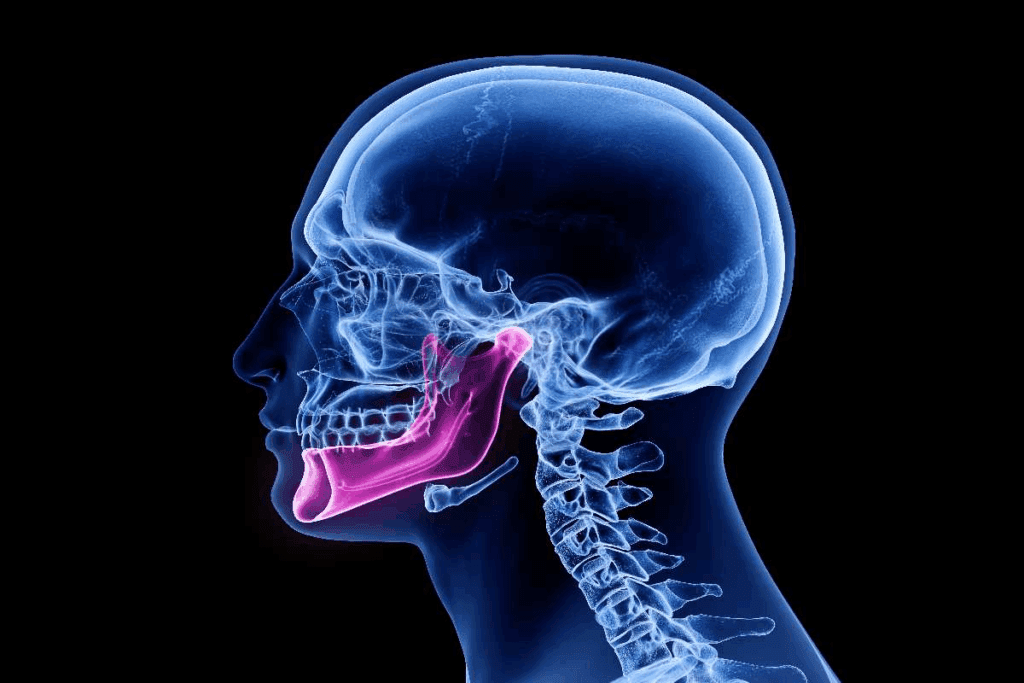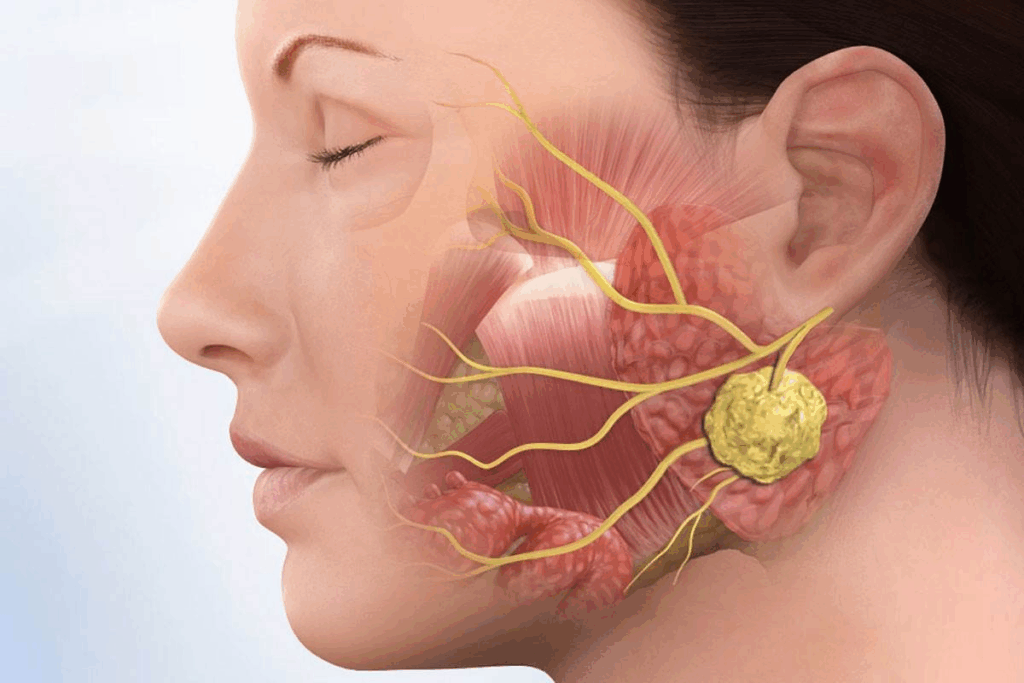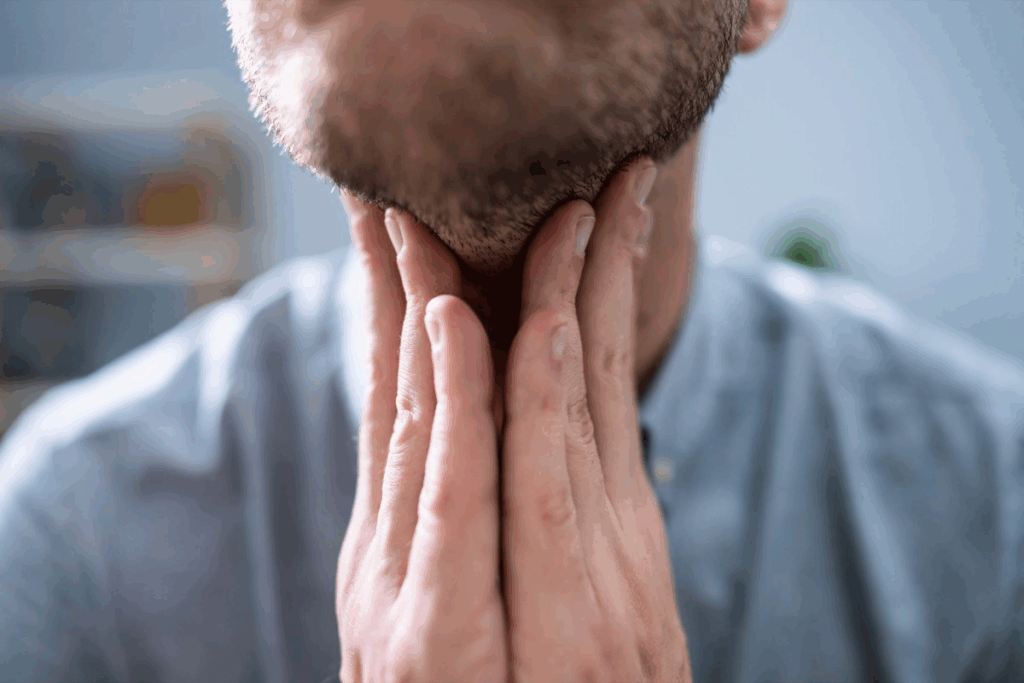Last Updated on November 27, 2025 by Ugurkan Demir

Jawbone cancer is a rare type of head and neck cancer. It makes up about 4 percent of all cancers in the United States. Early detection is key, as catching oral cavity cancer early can lead to an 80 to 90 percent recovery rate. Knowing the early warning signs and symptoms can save lives. The 7 most important jawbone cancer signs and symptoms, including pain, swelling, and changes in dental fit.
At Liv Hospital, we stress the need to spot jawbone cancer symptoms early. Our team uses a patient-focused approach to evaluate and treat with top international standards. It’s important to watch for key signs and symptoms like jaw pain, swelling, loose teeth, and numbness to get medical help quickly.

It’s important to know about jawbone cancer for early detection and treatment. Jawbone cancer starts in the jawbone. It’s different from mouth or throat cancers.
Jawbone cancer is when cells in the jawbone grow too much. This can damage and spread to other tissues. It’s similar to oral cavity cancer, which affects the mouth.
The American Cancer Society says there are about 54,540 new cases of oral cavity or oropharyngeal cancers each year. Not all are jawbone cancers, but it shows how common cancers in this area are.
Jawbone cancer is rare compared to other head and neck cancers. It’s a part of oral cavity cancers, which are a small part of all cancers.
Because jawbone cancer is rare, exact numbers are hard to find. But knowing about oral cancers helps us understand jawbone cancer better.
There are different types of jawbone cancer, like osteosarcoma, chondrosarcoma, and Ewing’s sarcoma. Each type is different and can grow at different rates.
Knowing the exact type of jawbone cancer is key for the right treatment.

Jawbone cancer can be caused by many things, like lifestyle and genes. Knowing these factors helps prevent and treat the disease early.
Our choices affect our risk for jawbone cancer. Tobacco use is the biggest risk, causing most cases. Tobacco’s chemicals can change jawbone cells’ genes, leading to cancer.
Heavy alcohol use also raises the risk, even more when combined with tobacco. Other dangers, like radiation, can increase the risk too.
Genes also play a big part in jawbone cancer risk. Syndromes like Li-Fraumeni and Familial adenomatous polyposis raise the risk of many cancers, including jawbone cancer.
People with a family history of cancer should get genetic counseling. This can help understand their risk.
Medical conditions before cancer can also raise the risk. For example, those exposed to radiation in the head and neck are at higher risk.
Dental issues and poor oral health might also increase the risk. But scientists are studying this more.
In summary, jawbone cancer risk comes from lifestyle, environment, genes, and health conditions. Knowing these can help prevent and treat the disease early.
Jawbone cancer is much easier to treat if caught early. This shows why finding it early is so important. Early detection can lead to a much better chance of recovery, with up to 90 percent of patients surviving.
This big difference in survival rates highlights the need to understand how to spot jaw cancer early. Regular screenings play a big role in this.
Early detection of oral cancer greatly improves treatment success. Patients diagnosed early have a much better chance of survival. Early detection is key to improving jawbone cancer survival rates, and we stress the importance of knowing early stage jaw cancer symptoms.
There are big challenges in spotting jawbone cancer early. Symptoms can be vague and similar to other, less serious issues. This makes it vital for doctors to be on the lookout and for patients to watch for any changes in their mouth.
We talk about the need for early detection of jaw cancer and the role of regular dental visits.
Regular dental visits are key for catching jawbone cancer early. We suggest that people, and those at higher risk, get screened often. These screenings can spot problems or jaw cancer diagnosis early, when they’re easier to treat.
By understanding the importance of early detection and the challenges it faces, we can work to improve survival rates for jawbone cancer patients. It’s a team effort that needs awareness, watchfulness, and regular screenings.
It’s important to know the signs and symptoms of jaw cancer for early treatment. Jawbone cancer shows itself in different ways. Knowing these signs can help you get medical help when needed.
Symptoms of jawbone cancer start slowly, with small changes that grow over time. At first, you might feel a little pain or discomfort in your jaw. This can be mistaken for other issues. As the cancer grows, these symptoms get worse and last longer.
Early signs include persistent soreness and pain in the mouth, trouble opening or closing your jaw, and swelling in the jaw area. It’s key to watch for these changes and see a doctor if they don’t go away.
In the early stages, symptoms are mild and hard to spot, making it tough to diagnose. As the cancer gets worse, symptoms get stronger. You might feel numbness or pain in the mouth or lips, have loose teeth, or notice changes in how your teeth line up.
When the cancer is more advanced, you might feel neurological symptoms like numbness, tingling, or pain in your face, jaw, or ear. These symptoms can really affect your life and need quick medical care.
If you have any symptoms that don’t go away or seem odd, see a doctor right away. Catching jawbone cancer early can make treatment much more effective. Look out for symptoms like mouth sores that don’t heal, unexplained bleeding, or persistent pain in your jaw or mouth.
Going to the dentist regularly can also spot problems early. If you’re worried about your symptoms or oral health, get medical advice without delay.
Mouth pain that lasts can be a sign of jawbone cancer. It’s important to notice persistent soreness and pain in the mouth. We’ll look at how to tell this pain from other mouth problems and share what patients have said.
It’s key to tell cancer pain from other types of pain. Cancer pain in the jawbone is often different. It can be constant and may come with swelling or trouble swallowing.
Key differences between cancer pain and other oral pain:
Jaw cancer pain can feel different for everyone. Some feel a dull ache, while others have sharp pains. Knowing these patterns can help catch cancer early.
Pain Characteristic | Description |
Dull Ache | Often described as a persistent, nagging pain |
Sharp Pain | Can be stabbing or shooting, often triggered by specific actions like chewing |
Radiating Pain | Pain that spreads to other areas such as the ear or neck |
Patient stories can give us clues about jawbone cancer. Some say their pain started after a dental visit. Others felt pain when eating or swallowing.
“I thought it was just a toothache, but the pain didn’t go away even after the tooth was extracted. It was later diagnosed as jawbone cancer.”
These stories show how important it is to watch for ongoing pain. If it doesn’t get better, see a doctor.
Having trouble opening or closing your jaw can really affect your life. It might happen for many reasons, like tumors in the jaw or nearby tissues.
When you can’t open or close your jaw easily, it changes your daily life. Simple things like eating, talking, and brushing your teeth become hard. This symptom can really upset you and affect your happiness.
This issue can make a big difference in your day. It might lead to:
TMJ disorders can also make it hard to open or close your jaw. But, the reasons and signs are different from jawbone cancer. It’s important to tell them apart to get the right treatment.
Characteristics | Jawbone Cancer | TMJ Disorders |
Primary Cause | Tumors affecting the jawbone | Joint inflammation, misalignment |
Pain Pattern | Often persistent and progressive | Typically related to jaw movement |
Associated Symptoms | Swelling, numbness, loose teeth | Clicking, locking of the jaw |
Jaw problems from cancer can get worse if not treated. Finding and treating it early is key. We stress the need to see a doctor if symptoms don’t go away or get worse.
Signs you should see a doctor include:
Understanding jaw problems helps us tackle them better. This way, we can improve how well we help our patients.
Seeing swelling or lumps in the jaw can be scary. It’s a sign that needs a doctor’s check-up. These signs can mean different things, like jawbone cancer. We’ll look at what these signs look like, how to tell if it’s cancer, and how to check yourself.
Swelling from jawbone cancer can start small and painless. It can grow bigger over time. Watch for any changes in size, shape, or how tender it feels.
As it gets worse, the swelling might hurt more. It could also affect how you eat or speak. This is because it presses on nerves or tissues.
Swelling in the jaw can mean cancer, but it’s more often from other things like infections or cysts. To figure out what it is, doctors use tests like X-rays or MRIs.
Here’s how to tell the difference:
Characteristic | Cancerous Swelling | Non-cancerous Swelling |
Pain | Often painless at first, but can hurt more as it grows | Can hurt, often if it’s infected or inflamed |
Growth Rate | Grows steadily over time | Can change size or stay the same |
Associated Symptoms | May cause numbness, trouble swallowing, or dental issues | Usually shows signs of infection like redness or pus |
Checking yourself regularly can help find jawbone cancer early. Here’s how to do it:
Spotting problems early is key to treating them well. Knowing the signs and checking yourself often can help keep your mouth healthy.
Tumors near the jawbone can cause teeth to become loose and dental alignment to change. Jawbone cancer is a serious condition that can lead to these symptoms. It’s important to recognize them early.
Tumors near the jawbone can put pressure on teeth and bone. This pressure can make teeth loose or shift their position.
The impact on dentition can be significant. It affects not just how your teeth look but also how well they work and your overall oral health.
Loose teeth and dental alignment changes can have many causes. These include periodontal disease or trauma, not just jawbone cancer.
But, if jawbone cancer is the cause, you might also feel pain or swelling in your jaw. It’s vital to get a detailed check-up to find out why you’re experiencing these symptoms.
First, see a dentist if you have loose teeth or dental alignment issues. But, if your dentist thinks it might be jawbone cancer, they’ll send you to an oncologist.
An oncologist is an expert in cancer diagnosis and treatment. They can give a detailed evaluation and suggest the best treatment options.
Jawbone cancer can cause numbness in the mouth and face and ear pain. These signs show the cancer is getting worse. They should not be ignored.
Sensory changes in the mouth and face can be different. You might feel numbness, tingling, or a pins and needles feeling. This happens because the tumor presses on nerves.
Knowing these patterns helps doctors figure out how far the cancer has spread.
Referred pain to the ear is common in jawbone cancer. It happens when the tumor affects nerves that also go to the ear.
Referred pain mechanisms involve complex neurological pathways. This makes it hard to diagnose. But, knowing these patterns helps doctors spot jawbone cancer early.
In late stages, jawbone cancer can really mess with your nerves. This can cause:
These symptoms show why catching cancer early is so important. It helps avoid these serious nerve problems.
Early diagnosis and the right treatment can greatly improve survival chances for jawbone cancer patients. We will look at the diagnostic steps, treatment methods, and ways to prevent this disease.
To diagnose jawbone cancer, doctors use physical exams, imaging tests, and biopsies. Imaging tests like X-rays and CT scans show where and how big the tumor is.
The treatment for jawbone cancer depends on the cancer’s stage, location, and the patient’s health. Multidisciplinary care from surgeons, oncologists, and others is often needed.
Success rates change based on when the cancer is found and the treatment plan. Early cancers usually have better results with the right treatment.
To prevent jawbone cancer, it’s important to lower risk factors and live a healthy lifestyle. Regular dental check-ups and avoiding tobacco and alcohol can help a lot.
Knowing about diagnosis, treatment, and prevention helps patients manage their care better and improve their chances of recovery.
It’s important to know the signs of jawbone cancer early. This helps in getting the right treatment. We talked about symptoms like jaw pain, trouble opening the jaw, and swelling.
Seeing a doctor early can make a big difference. Knowing the signs helps you act fast. Regular check-ups are key to catching problems early.
Being aware of jawbone cancer signs can help everyone. If you notice anything odd, see a doctor right away. This way, we can all work towards better treatment outcomes.
Signs include persistent pain and soreness in the mouth. You might also have trouble opening or closing your jaw. Visible swelling, lumps, and loose teeth are common. Changes in dental alignment, numbness, and ear pain can also occur.
Jawbone cancer pain is often constant and comes with swelling, loose teeth, or trouble swallowing. If you have persistent pain, see a healthcare professional for a check-up.
Risk factors include tobacco and alcohol use, genetic predispositions, and certain medical conditions. Viral infections or radiation exposure can also increase your risk.
Diagnosis involves imaging tests like X-rays, CT scans, or MRI scans. A biopsy is then done to confirm cancer cells.
Treatment options include surgery, radiation therapy, chemotherapy, or a mix of these. The choice depends on the cancer’s stage and type.
Preventing jawbone cancer is not guaranteed. But, avoiding tobacco and alcohol, keeping good oral health, and limiting radiation exposure can lower your risk.
Early detection is key for better survival rates and treatment outcomes. Regular screenings and knowing the signs can help catch the disease early.
Jawbone cancer can change dental alignment due to tumor growth. This can cause loose teeth or changes in the jaw structure.
Self-examination is not a full substitute for professional checks. But, noticing changes in your jaw, like swelling or pain, can prompt you to seek medical help.
Yes, TMJ disorders can be mistaken for jawbone cancer symptoms, like jaw opening or closing issues. A detailed medical evaluation is needed to tell them apart.
World Health Organization. (2025). 7 Jawbone Cancer Signs and Symptoms to Know. Retrieved from https://www.who.int/news-room/fact-sheets/detail/oral-health
Subscribe to our e-newsletter to stay informed about the latest innovations in the world of health and exclusive offers!